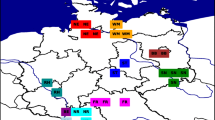Summary
The influence of the meteorological parameters: maximum and minimum temperatures, relative humidity, rainfall and duration of sunshine, on sugarcane yield, is studied by fitting third-degree response function models using the long-period experimental data at the Regional Agricultural Research Station at Anakapalle (17°38′N, 83°01′E), Andhra Pradesh, India. These models give the quantitative response in the yield brought about by a unit change in the meteorological parameters at each stage of the crop growth. The maximum and minimum temperatures and relative humidity during the first three months of the crop (germination and tillering phases), are found to have a profound influence on the yield. Above normal temperatures and drier conditions at this time seem to be favourable for good yields. Presuming that the year-to-year variations of the meteorological parameters are largely the reflections of the broad synoptic systems prevailing over and around the area of study, an attempt has been made to identify the macrometeorological situations that critically affect the sugarcane yield. This is accomplished through selected case studies of weather situations during the critical periods obtained above, for some poor-yield and good-yield years. This study helps in fixing the favourable and unfavourable macrometeorological systems, which could be useful for issuing special agrometeorological forecasts for sugarcane growers and crop-outlook statements.
Zusammenfassung
Der Einfluß der meteorologischen Parameter Maximum- und Minimum-Temperatur, relative Feuchte, Niederschlag und Sonnenscheindauer auf den Zuckerrohrertrag wird durch Angleichen von respondierenden Funktionsmodellen dritten Grades studiert, welche langfristige Daten der regionalen landwirtschaftlichen Forschungsstation in Anakapalle (17°38′N, 83°01′E), Andhra Pradesh, Indien, benützen. Diese Modelle liefern ein quantitatives Ansprechen des Ertrages, der durch Änderung in den meteorologischen Parametern um je eine Einheit in jedem Stadium der Wachstumsentwicklung hervorge rufen wird. Der stärkste Einfluß auf den Ertrag wird durch Maximum- und Minimum-Temperaturen und durch die Feuchte während der ersten drei Monate des Wachstums (Keimungs- und Sprossungsphasen) hervorgerufen. Übemormale Temperaturen und verhältnismäßig trockene Bedingungen während dieser Zeit scheinen sich vorteilhaft auf den Ertrag auszuwirken. Unter der Annahme, daß die interannuale Veränderlichkeit der meteorologischen Parameter hauptsächlich durch die großräumigen synoptischen Systeme im Raume der Beobachtungsstation bestimmt wird, wurde versucht, die makrometeorologischen Lagen, welche den Zuckerrohrertrag beeinflussen, zu identifizieren. Dies wurde durch Studien selektiver Fälle von Wetterlagen während der kritischen Zeitperioden in etlichen Jahren mit schlechtem und mit gutem Ertrag bewerkstelligt. Die Identifizierung von günstigen und ungünstigen Wetterlagen kann in der Herausgabe von speziellen, agrarmeteorologischen Vorhersagen für Zuckerrohrplantagen und für Ertragsabschätzungen von Nutzen sein.
Similar content being viewed by others
References
Acharya, R. C., Alam, M. N., Sinha, A. B. B., Khanna, K. L.: Studies on Crop-Weather Relationship II. The Influence of Weekly Rainfall on Sugarcane Yields at the Government Experimental Farm, Pusa, Bihar. Indian J. Sugarcane Res.4, 187–191 (1960).
Fisher, R. A.: The Influence of Rainfall on the Yield of Wheat at Rothamsted. Roy. Soc. (London) Phil. Trans. Ser. B213, 89–142 (1924).
Gangopadhyaya, M., Sarker, R. P.: A Correlation Study on Crop-Weather Relationships — Sugarcane. Indian J. Sugarcane Res.8, 1–12 (1963).
Godhara, M. S.: Agro-Ecological Conditions in Rajasthan and Their Relative Effects on Sugarcane Cultivation. Indian J. Sugarcane Res.7, 149–157 (1963).
Hendricks, W. A., Scholl, J. C.: Techniques in Measuring Joint-Relationships: The Joint Effects of Temperature and Precipitation on Corn Yields, North Carolina Agric. Exp. Sta. Tech. Bull.74 (1943).
Khanna, K. L.: Unprecedented Heat Wave During April–June in Bihar and its Attendant Consequences. Indian J. Sugarcane Res.4, 176–177 (1960).
Khanna, K. L., Sehgal, B. R.: Studies on Crop-Weather Relationship I. Influence of Rainfall on the Yield of Sugarcane. Indian J. Sugarcane Res.1, 85–95 (1957).
Mallik, A. K., Pimpalwadkar, P. V.: Sugarcane Crop in Relation to Weather. Indian J. Sugarcane Res.7, 77–82 (1963).
Raheja, P. C.: Analysis of Sugarcane Yields 11. Relative Influence of Season, Irrigation, Intervals, Methods of Planting and Nitrogen Doses on Yield and Quality of Cane. Indian J. Agric. Sci.21, 203–214 (1951).
Rao, K. K.: Factors Influencing the Growth and Sugar Contents of Cane. Agric. J. of India24, 91–101 (1929).
Runge, E. C. A.: Effects of Rainfall and Temperature Interactions During the Growing Season on Corn Yield. Agron. J.60, 503–507 (1968).
Runge, E. C. A., Odell, R. T.: The Relation Between Precipitation, Temperature and the Yield of Corn on the Agronomy South Farm, Urbana, Illinois. Agron. J.50, 448–454 (1958).
Sarker, R. P.: A Curvilinear Study of Yield with Reference to Weather — Sugarcane. Indian J. Met. and Geoph.16, 103–110 (1965).
Subbaramayya, I., Rupa Kumar, K.: Crop-Weather Relationships of Sugarcane and Yield Prediction in Northeast Andhra Pradesh, India. Agric. Met.21, 265–279 (1980).
Tromp, S. W.: Biometeorology — The Impact of the Weather and Climate on Humans and their Environment (Animals and Plants), 1st ed. London: Heyden and Son Ltd. 1980.
Wilsie, C. P.: Crop Adaptation and Distribution, 1st ed. New Delhi (Indian Reprint): Eurasia Publishing House Pvt. Ltd. 1974.
Author information
Authors and Affiliations
Additional information
With 2 Figures
Rights and permissions
About this article
Cite this article
Rupa Kumar, K. Yield response of sugarcane to weather variations in Northeast Andhra Pradesh, India. Arch. Met. Geoph. Biocl., Ser. B 35, 265–276 (1984). https://doi.org/10.1007/BF02263351
Received:
Issue Date:
DOI: https://doi.org/10.1007/BF02263351




